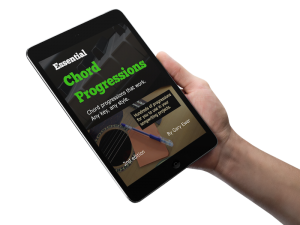For most songs, the verse and chorus melodies are different. That’s the most common circumstance. But there are times, you will notice, when you’ve written a verse and a chorus that sound fine on their own, but don’t seem to work together.
On the face of it, it seems that there doesn’t need to be much similarity at all between verse and chorus, and all you need to do is listen carefully to examples of hit songs from every decade of the history of popular music for evidence:
- “Roses Are Red (My Love”) – Paul Evans, Al Byron (1962)
- “You’ve Got a Friend” – Carole King (1971)
- “Africa” – David Paich, Jeff Porcaro (1983)
- “Poker Face” – Lady Gaga, Nadir Khayat (2009)
But as a songwriter, you may have noticed in your own writing that it is possible to write a verse that just doesn’t seem to work well with your chorus hook. There is some sort of important relationship between verse and chorus that seems to be necessary, even if all the notes are different.
 Looking for lists of progressions you can use in your own songs? “The Essential Secrets of Songwriting” eBook Bundle has 2 main collections, plus eBooks on how to harmonize your own melodies, and more.
Looking for lists of progressions you can use in your own songs? “The Essential Secrets of Songwriting” eBook Bundle has 2 main collections, plus eBooks on how to harmonize your own melodies, and more.
What is that connection? What makes a verse a good musical companion for a chorus? Take a look at the following list:
- Basic Contrast. Assuming you’ve written the chorus hook first, you want a verse that explores some of the opposite qualities. A good sense of contrast as you switch from verse to chorus raises the interest level of the music in ways that can spell success or failure.
- Melodic contrast. In “Poker Face” we hear a verse with lots of repeated notes, almost droning in the lower register of the voice. The chorus melody moves higher, but as you can hear, moves around in a more energetic way, changing the song’s mood.
- Rhythmic change. In many songs, the verse melody uses more active (and sometimes complex) rhythms, switching to something more predictable, strong and basic for the chorus. That switch to simplicity allows for the chorus hook to do its work: play on the emotions of the listener. The change is usually very subtle, and in fact if the rhythmic change is extreme, it can prevent the verse from operating as a strong musical partner for the chorus. So listen again to “Africa” and notice that the chorus uses a slightly more predictable rhythmic pattern than the verse.
- Key change. For songs with a minor key verse, like “You’ve Got a Friend”, it may not be immediately noticeable that the verse and chorus melodies use many of the same basic shapes, but in a minor key for the verse and major key for the chorus. The change from minor to major is a common technique in many different eras and genres of pop music, still common today.
- Lyrical progression. The way a song’s lyric unfolds is a crucial part of the connection between verse and chorus, providing the necessary musical glue that joins it all together. A verse lyric will describe people, circumstances and situations, switching to an emotional “this is how I feel about that” kind of lyric for the chorus, and that’s usually crucial to the success of any song.
As you write your songs, if your feeling is that the verse and chorus just don’t seem to have much to do with each other, ask yourself the following questions:
- Have I used anything similar between verse and chorus? It might be the chords, it might be some of the basic backing rhythms… anything to help the two sections communicate.
- Have I used anything purposefully different between verse and chorus? For example, if your chorus uses mainly upward-moving melodic shapes, you might try deliberately using downward shapes for the verse. (Example: “Roses Are Red (My Love)”
- Is my lyric progressing logically from describing to emoting? In order for a chorus to work well, the emotions need a reason for existing. If your verse isn’t setting up a situation for which the singer can provide a reaction, the disconnect can be too great between verse and chorus.
And just to say it clearly: a verse and chorus melody can successfully have nothing much to do with each other. And it’s worth the time to take a look at successful hit songs from the past several decades and note how similar or not their verse and chorus are. I think you’ll be surprised that the important connection is often made using non-melody elements.
 Written by Gary Ewer. Follow Gary on Twitter.
Written by Gary Ewer. Follow Gary on Twitter.
 Even if you don’t have a background in music theory, there’s a lot about chord theory you can discover and use! Several eBooks in “The Essential Secrets of Songwriting” 10-eBook bundle (plus the free “Use Your Words!”) show you exactly why chords work the way they do, and then show you how to use them in your own songs.
Even if you don’t have a background in music theory, there’s a lot about chord theory you can discover and use! Several eBooks in “The Essential Secrets of Songwriting” 10-eBook bundle (plus the free “Use Your Words!”) show you exactly why chords work the way they do, and then show you how to use them in your own songs.










